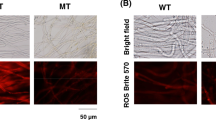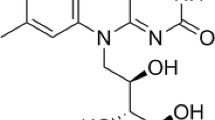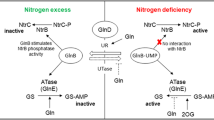Abstract
The filamentous fungus Ashbya gossypii is used for riboflavin biosynthesis on an industrial scale, but even the wild type displays overproduction. Because riboflavin overproduction was known to start at the transition between growth and stationary phase, it was suspected that overproduction was induced at low growth rates. However, chemostatic cultivations performed at different growth rates did not result in any detectable riboflavin formation. In this study, we report that it was not the final growth rate that triggered riboflavin overproduction but a decline in growth rate. Therefore, continuous fermenter cultivations with dilution rate shifts were performed. Peaks of riboflavin overproduction were observed in the wild type and in a RIB3placZ reporter strain after downshifts in dilution rate. Accumulation of riboflavin correlated with an increased expression of lacZ reporter activity. The step size of the downshifts corresponded to the peak size of riboflavin formation and reporter activity. Expression of further RIB genes encoding riboflavin biosynthetic enzymes was analyzed by RT-PCR. RIB mRNA levels of the ribulose-5-phosphate branch of the divided riboflavin biosynthesis pathway (RIB3, RIB4, and RIB5) were found to increase in the riboflavin production phase, whereas the RIB2 and RIB7 mRNA levels belonging to the GTP branch remained constant. We propose that a decline in growth rate triggers the increased expression of RIB3, RIB4, and RIB5 resulting in riboflavin overproduction. Because although a reduction in oxygen supply, temperature increase or decrease, or salt stress did affect growth, but neither did lead to riboflavin overproduction nor did induce RIB3 reporter expression, we conclude that declining nutrition must be the stress stimulus. Because about half of the cells in the hyphae of Ashbya gossypii did not accumulate riboflavin, the regulatory response on the cellular level can be estimated to be at least twice as great in comparison to what we detected as overall signals.






Similar content being viewed by others
References
Althöfer H, Seulberger H, Zelder O, Revuelta JL (1999) Genetic method for producing riboflavin, Patent no. WO 99/61623
Bacher A (1991) Biosynthesis of flavins. In: Müller F (ed) Chemistry and biochemistry of flavoenzymes. CRC Press, Boston, pp 215–259
Demain AL (2000) Microbial biotechnology. Trends Biotechnol 18:26–31
Dietrich FS, Voegeli S, Brachat S, Lerch A, Gates K, Steiner S, Mohr C, Pöhlmann R, Luedi P, Choi S, Wing RA, Flavier A, Gaffney TD, Philippsen P (2004) The Ashbya gossypii genome as a tool for mapping the ancient Saccharomyces cerevisiae genome. Science 304:304–307
Förster C, Santos MA, Ruffert S, Kramer R, Revuelta JL (1999) Physiological consequence of disruption of the VMA1 gene in the riboflavin overproducer Ashbya gossypii. J Biol Chem 274:9442–9448
Förster C, Revuelta JL, Kramer R (2001) Carrier-mediated transport of riboflavin in Ashbya gossypii. Appl Microbiol Biotechnol 55:85–89
García-Ramírez JJ, Santos MA, Revuelta JL (1995) The Saccharomyces cerevisiaeRIB4 gene codes for 6,7-dimethyl-8-ribityllumazine synthase involved in riboflavin biosynthesis. J Biol Chem 270:23801–23807
Mateos L, Jimenez A, Revuelta JL, Santos MA (2006) Purine biosynthesis, riboflavin production, and trophic-phase span are controlled by a Myb-related transcription factor in the fungus Ashbya gossypii. Appl Environ Microbiol 72:5052–5060
Monschau N, Sahm H, Stahmann KP (1998) Threonine aldolase overexpression plus threonine supplementation enhanced riboflavin production in Ashbya gossypii. Appl Environ Microbiol 64:4283–4290
Revuelta JL, Buitrago MJ, Santos MA (1995) Riboflavin biosynthesis in fungi. Patent no. WO 95/26406
Santos MA, García-Ramírez JJ, Revuelta JL (1995) Riboflavin biosynthesis in Saccharomyces cerevisiae. Cloning, characterization, and expression of the RIB5 gene encoding riboflavin synthase. J Biol Chem 270:437–444
Schlösser T, Schmidt G, Stahmann KP (2001) Transcriptional regulation of 3,4-dihydroxy-2-butanone 4-phosphate synthase. Microbiology 147:3377–3386
Sibirny AA (1996) Pichia guilliermondii. In: Wolf K (ed) Nonconventional yeasts in biotechnology. Springer, Berlin, pp 255–275
Stahmann KP, Revuelta JL, Seulberger H (2000) Three biotechnical processes using Ashbya gossypii, Candida famata, or Bacillus subtilis compete with chemical riboflavin production. Appl Microbiol Biotechnol 53:509–516
Stahmann KP, Arst HN, Althöfer H, Revuelta JL, Monschau N, Schlüpen C, Gätgens C, Wiesenburg A, Schlösser T (2001) Riboflavin, overproduced during sporulation of Ashbya gossypii, protects its hyaline spores against ultraviolet light. Environ Microbiol 3:545–550
Straube G, Fritsche W (1973) The influence of iron concentration and temperature on growth and riboflavin overproduction of Candida guillermondii. Biotechnol Bioeng Symp 4:225–231
Wendland J, Walther A (2005) Ashbya gossypii: a model for fungal developmental biology. Nat Rev Microbiol 3:421–429
Wickerham LJ, Flickinger MH, Johnsten RM (1946) The production of riboflavin by Ashbya gossypii. Arch Biochem 9:95–98
Acknowledgments
We thank Janet Carter-Sigglow for revising the language of the manuscript. We are grateful for many years of helpful discussions and much more to Jose L. Revuelta and Maria A. Santos. Many thanks are due to Marvin Karos and Claus Bollschweiler. Fruitful input was provided by Roland Kurth, Bruno Kaesler, Oskar Zelder, and Harald Seulberger. Part of this work was supported by BASF AG. Hermann Sahm was always the driving force in questions of regulation. He proposed an upregulation of the gene encoding HBS in 1991. The stimulating atmosphere in his institute created excellent working conditions.
Author information
Authors and Affiliations
Corresponding author
Additional information
This paper is dedicated to Professor Dr. Hermann Sahm on the occasion of his 65th birthday.
Rights and permissions
About this article
Cite this article
Schlösser, T., Wiesenburg, A., Gätgens, C. et al. Growth stress triggers riboflavin overproduction in Ashbya gossypii . Appl Microbiol Biotechnol 76, 569–578 (2007). https://doi.org/10.1007/s00253-007-1075-9
Received:
Revised:
Accepted:
Published:
Issue Date:
DOI: https://doi.org/10.1007/s00253-007-1075-9




